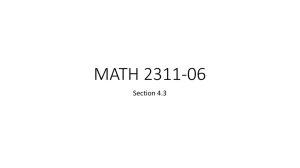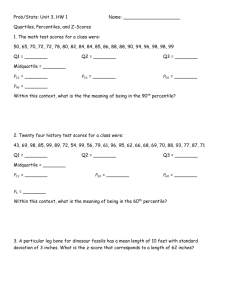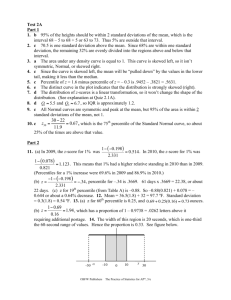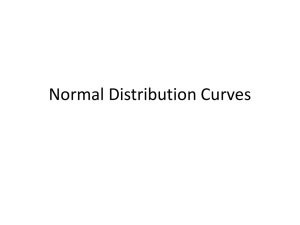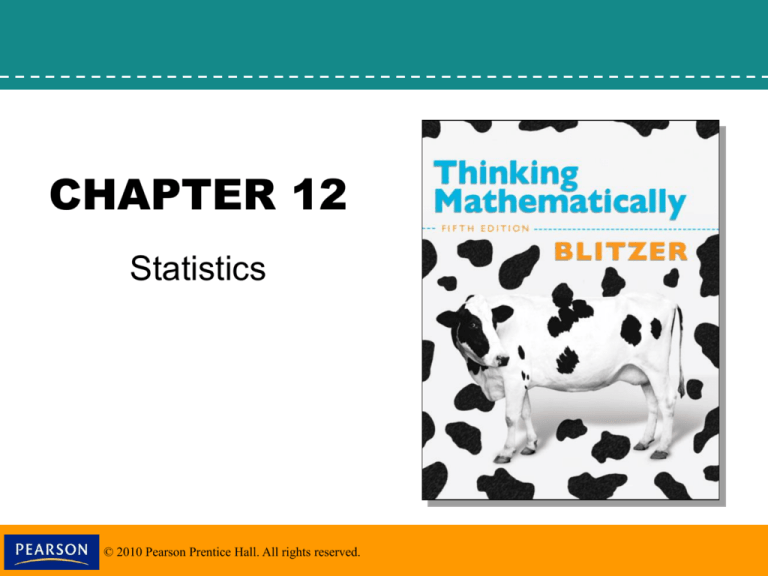
CHAPTER 12
Statistics
© 2010 Pearson Prentice Hall. All rights reserved.
12.5
Problem Solving with the Normal
Distribution
© 2010 Pearson Prentice Hall. All rights reserved.
2
Objectives
1. Solve applied problems involving normal
distribution.
© 2010 Pearson Prentice Hall. All rights reserved.
3
Example 1: Finding the Percentage of Data
Items Less Than a Given Data Item
According to the Department of Health and Education,
cholesterol levels are normally distributed. For men
between 18 and 24 years, the mean is 178.1 and the
standard deviation is 40.7. What percentage of men in
this age range have a cholesterol level less than 239.15?
Solution:
Compute the z-score for a 239.15 cholesterol level.
z239.15
data item - mean
239.15 178.1 61.05
1.5
standard deviation
40.7
40.7
© 2010 Pearson Prentice Hall. All rights reserved.
4
Example 1 continued
We must find the percentage of men with a cholesterol
level less than z = 1.5. The table gives this percentage
as a percentile. Finding 1.5 in the z-score column gives
a percentile of 93.32. Thus , 93.32% of men between
18 and 24 have a cholesterol level less than 239.15.
z-score
Percentile
1.4
1.5
1.6
91.92
93.32
94.52
© 2010 Pearson Prentice Hall. All rights reserved.
5
Finding the Percentage of Data Items Between
Two Given Data Items.
© 2010 Pearson Prentice Hall. All rights reserved.
6
Example 3: Finding the Percentage of Data
Items Between Two Given Data Items
The amount of time that self-employed Americans work
each week is normally distributed with a mean of 44.6
hours and a standard deviation of 14.4 hours. What
percentage of self-employed individuals in the United
States work between 37.4 and 80.6 hours per week?
Solution:
Step 1 Convert each given data item to a z-score.
data item - mean
37.4 44.6 - 7.2
0.5
standard deviation
14.4
14.4
z37.4
z80.6
data item - mean
80.6 44.6 36
2.5
standard deviation
14.4
14.4
© 2010 Pearson Prentice Hall. All rights reserved.
7
Example 3 continued
Step 2 Use the Table to find the percentile corresponding
to these z-scores. The percentile corresponding to −0.50
is 30.85. This means that 30.85% of self-employed
Americans work fewer than 37.4 hours per week.
The Table also shows that the percentile that corresponds
to a z-score of 2.5 is 99.38.
That means that 99.38% of self-employed Americans
work fewer than 80.6 hours per week.
© 2010 Pearson Prentice Hall. All rights reserved.
8
Example 3 continued
Step 3 Subtract the lesser percentile from the greater
percentile and attach a % sign.
99.38 – 30.85 = 68.53.
= 68.53 %
Thus, 68.53% of
self-employed
Americans work between
37.4 and 80.6 hours per week.
© 2010 Pearson Prentice Hall. All rights reserved.
9
Summary of Computing Percentage of
Data Items for Normal Distributions
Description of Percentage
Percentage of data
items less than a given
data item with z = b
Percentage of data
items greater than a
given data item with
z=a
Percentage of data
items between two
given data items with
z = a and z = b
Graph
© 2010 Pearson Prentice Hall. All rights reserved.
Computation of Percentage
Use the table percentile
for z = b and add a % sign
Subtract the table percentile
for z = a from 100 and add
a % sign.
Subtract the table percentile
for z = a from the table
percentile for z = b and add
a % sign.
10


